Status of Typical Artificial Lighting Environments in Different Public Buildings in China, and Requirements for Their Improvement
Abstract
:1. Introduction
1.1. Luminous Environment
1.2. Luminous Comfort
1.3. Evaluation of Luminous Comfort
1.4. Purpose of This Study
2. Methodology
2.1. Questionnaire
2.2. Pilot Study
2.3. Sampling
2.4. On-Site Measurement
2.5. Data Processing and Analysis
3. Results
3.1. Descriptive Analysis of Overall Satisfaction
3.2. Potential Factors for Luminous Environment Improvement
3.3. Thresholds of Potential Factors
3.4. Luminous Environment Improvement System for Office Buildings
4. Discussion
4.1. Comparative Analysis of Different Public Buildings
4.2. Negative Correlations between Subjective Feelings and Objective Factors
4.3. Thresholds of Illuminance, CCT
4.4. Limitations
5. Conclusions
- (1)
- Current lighting standards were met in over 60% of public building contexts.
- (2)
- Different environments have distinct demands for optimizing the lighting conditions.
- (3)
- By utilizing a specific set of metrics and thresholds, the required level of improvement in each scenario was quantified.
Author Contributions
Funding
Data Availability Statement
Acknowledgments
Conflicts of Interest
Appendix A

References
- Rea, M.S.; Figueiro, M.G.; Bierman, A.; Bullough, J.D. Circadian Light. J. Circadian Rhythms 2010, 8, 2–11. [Google Scholar] [CrossRef] [PubMed]
- Wang, S.; Zhao, J.; Wang, L.; Hu, W.; Yan, F. A Mathematical Model for the Action Spectrum of Steady-State Pupil Size in Photopic Vision with Insight into Healthful Lighting. Buildings 2023, 13, 781. [Google Scholar] [CrossRef]
- Jin, L.; Xue, P.; Zhang, L.; Wang, J.; Shi, J.; Liang, Q.; Cao, X.; Xu, N.; Liao, J. Visual and non-visual effects of integrated lighting based on spectral information. Build. Environ. 2023, 242, 110617. [Google Scholar] [CrossRef]
- Potočnik, J.; Košir, M. The Necessity for Multi-Spectral Simulations of the Indoor Non-Visual Luminous Environment: A Simplified Annual Approach. Buildings 2023, 13, 1357. [Google Scholar] [CrossRef]
- Boyce, P.R. Human Factors in Lighting, 3rd ed.; Taylor and Francis: Abingdon, UK, 2014. [Google Scholar]
- Ochoa, C.E.; Capeluto, L.G. Evaluating visual comfort and performance of three natural lighting systems for deep office buildings in highly luminous climates. Build. Environ. 2006, 41, 1128–1135. [Google Scholar] [CrossRef]
- Tong, L.; Liu, N.; Hu, S.; Lu, M.; Zheng, Y.; Ma, X. Research on the Preferred Illuminance in Office Environments Based on EEG. Buildings 2023, 13, 467. [Google Scholar] [CrossRef]
- Wang, Q.; Xu, H.S.; Gong, R.; Cai, J.Q. Investigation of visual fatigue under LED lighting based on reading task. Optik 2015, 126, 1433–1438. [Google Scholar] [CrossRef]
- Collier, J.M.; Wilkerson, A.; Durmus, D.; Rodriguez-Feo Bermudez, E. Studying Response to Light in Offices: A Literature Review and Pilot Study. Buildings 2023, 13, 471. [Google Scholar] [CrossRef]
- Freewan, A.A.Y.; Dalala, J.A.A. Assessment of daylight performance of Advanced Daylighting Strategies in Large University Classrooms; Case Study Classrooms at JUST. Alex. Eng. J. 2020, 59, 791–802. [Google Scholar] [CrossRef]
- Dubois, M.C. Shading devices and daylight quality: An evaluation based on simple performance indicators. Light. Res. Technol. 2003, 35, 61–76. [Google Scholar] [CrossRef]
- Rasheed, E.O.; Khoshbakht, M.; Baird, G. Time spent in the office and workers’ productivity, comfort and health: A perception study. Build. Environ. 2021, 195, 107747. [Google Scholar] [CrossRef]
- Wymelenberg, K.; Inanici, M.; Johnson, P. The effect of luminance distribution patterns on occupant preference in a daylit office environment. Leukos 2011, 7, 103–122. [Google Scholar] [CrossRef]
- Xue, P.; Mak, C.M.; Ai, Z.T. A structured approach to overall environmental satisfaction in high-rise residential buildings. Energy Build. 2016, 116, 181–189. [Google Scholar] [CrossRef]
- Iacomussi, P.; Radis, M.; Rossi, G.; Rossi, L. Visual Comfort with LED Lighting. Energy Procedia 2015, 78, 729–734. [Google Scholar] [CrossRef]
- Wang, Q.; Xu, H.; Zhang, F.; Wang, Z. Influence of color temperature on comfort and preference for LED indoor lighting. Optik 2017, 129, 21–29. [Google Scholar] [CrossRef]
- Cho, Y.; Ryu, S.H.; Lee, B.R.; Kim, K.H.; Lee, E.; Choi, J. Effects of artificial light at night on human health: A literature review of observational and experimental studies applied to exposure assessment. Chronobiol. Int. 2015, 32, 1294–1310. [Google Scholar] [CrossRef] [PubMed]
- Liu, G.; Xu, Y.; Dang, R.; Luo, C. The Research of Triadic Relation among Building Spaces, Lighting Comfort Level and Lighting Energy Consumption in High-speed Railway Station in China. Procedia Eng. 2015, 121, 854–865. [Google Scholar]
- Zencirci, A.D.; Arslan, S. Morning-evening type and burnout level as factors influencing sleep quality of shift nurses: A questionnaire study. Croat. Med. J. 2011, 52, 527–537. [Google Scholar] [CrossRef]
- Xue, P.; Mak, C.M.; Huang, Y. Quantification of luminous comfort with dynamic daylight metrics in residential buildings. Energy Build. 2016, 117, 99–108. [Google Scholar] [CrossRef]
- Xue, P.; Mak, C.M.; Cheung, H.D.; Chao, J. Post-occupancy evaluation of sunshades and balconies’ effects on luminous comfort through a questionnaire survey. Build. Serv. Eng. Res. Technol. 2016, 37, 51–65. [Google Scholar] [CrossRef]
- Chraibi, S.; Lashina, T.; Shrubsole, P.; Aries, M.; Loenen, E.V.; Rosemann, A. Satisfying light conditions: A field study on perception of consensus light in Dutch open office environments. Build. Environ. 2016, 105, 116–127. [Google Scholar] [CrossRef]
- Gou, Z. Human factors in green building: Building types and users’ needs. Buildings 2019, 9, 17. [Google Scholar] [CrossRef]
- Lolli, N.; Nocente, A.; Grynning, S. Perceived control in an office test cell, a case study. Buildings 2020, 10, 82. [Google Scholar] [CrossRef]
- Shafavi, N.S.; Zomorodian, Z.S.; Tahsildoost, M.; Javadi, M. Occupants visual comfort assessments: A review of field studies and lab experiments. Sol. Energy 2020, 208, 249–274. [Google Scholar] [CrossRef]
- Lan, L.; Hadji, S.; Xia, L.; Lian, Z. The effects of light illuminance and correlated color temperature on mood and creativity. In Building Simulation; Tsinghua University Press: Beijing, China, 2021; Volume 14, pp. 463–475. [Google Scholar]
- Boyce, P.R.; Cuttle, C. Effect of correlated colour temperature on the perception of interiors and colour discrimination performance. Light. Res. Technol. 1990, 22, 19–36. [Google Scholar] [CrossRef]
- Lu, M.; Hu, S.; Mao, Z.; Liang, P.; Xin, S.; Guan, H. Research on work efficiency and light comfort based on EEG evaluation method. Build. Environ. 2020, 183, 107122. [Google Scholar] [CrossRef]
- Veitch, J.A. Psychological processes influencing lighting quality. J. Illum. Eng. Soc. 2001, 4480, 124–140. [Google Scholar] [CrossRef]
- Fotios, S. A revised Kruithof graph based on empirical data. Leukos 2017, 13, 3–17. [Google Scholar] [CrossRef]
- Manav, B. An experimental study on the appraisal of the visual environment at offices in relation to colour temperature and illuminance. Build. Environ. 2007, 42, 979–983. [Google Scholar] [CrossRef]
- Iwata, T.; Hatao, A.; Shukuya, M.; Kimura, K. Visual comfort in the daylit luminous environment: Structural model for evaluation. Light. Res. Technol. 1994, 26, 91–97. [Google Scholar] [CrossRef]
- CIE S 017/E:2011; ILV: International Lighting Vocabulary. Commission Internationale de L'Eclairage: Vienna, Austria, 2011.
- Hamedani, Z.; Solgi, E.; Skates, H.; Hine, T.; Fernando, R.; Lyons, J.; Dupren, K. Visual discomfort and glare assessment in office environments: A review of light-induced physiological and perceptual responses. Build. Environ. 2019, 153, 267–280. [Google Scholar] [CrossRef]
- Hwang, T.; Jeong, T.K. Effects of indoor lighting on occupants’ visual comfort and eye health in a green building. Indoor Built Environ. 2011, 20, 75–90. [Google Scholar] [CrossRef]
- Ooyen, M.V.; Weijgert, J.V.D.; Begeman, S. Preferred luminances in offices. J. Illum. Eng. Soc. 1987, 16, 152–156. [Google Scholar] [CrossRef]
- Carter, D.; Slater, A.; Perry, M.; Mansfield, K.; Loe, D.; Sandoval, J. The influence of luminance distributions on subjective impressions and performance within a non-uniformly lit office. In Proceedings of the CIBSE National Lighting Conference, London, UK, March 1994. [Google Scholar]
- Kort, Y.D.; Veitch, J.A. From blind spot into the spotlight. J. Environ. Psychol. 2014, 39, 1–4. [Google Scholar] [CrossRef]
- Smolders, K.; Kort, Y.D. Bright light and mental fatigue: Effects on alertness, vitality, performance and physiological arousal. J. Environ. Psychol. 2014, 39, 77–91. [Google Scholar] [CrossRef]
- Heerwagen, J.H.; Heerwagen, D.R. Lighting and psychological comfort. Light. Des. Appl. 1986, 16, 47–51. [Google Scholar]
- Carlucci, S.; Causone, F.; Rosa, F.D.; Pagliano, L. A review of indices for assessing visual comfort with a view to their use in optimization processes to support building integrated design. Renew. Sustain. Energy Rev. 2015, 47, 1016–1033. [Google Scholar] [CrossRef]
- Boyce, P.R. Light, lighting and human health. Light. Res. Technol. 2022, 54, 101–144. [Google Scholar] [CrossRef]
- Xie, J.C.; Xue, P.; Mak, C.M.; Liu, J. Balancing energy and daylighting performances for envelope design: A new index and proposition of a case study in Hong Kong. Appl. Energy 2017, 205, 13–22. [Google Scholar] [CrossRef]
- Alzoubi, H.H.; Al-Rqaibat, S.M. The effect of hospital design on indoor daylight quality in children section in King Abdullah University Hospital. Jordan Sustain. Cities Soc. 2015, 14, 449–455. [Google Scholar] [CrossRef]
- GB 50034: 2013; Standard for Lighting Design of Buildings. National Standard of the People’s Republic of China: Beijing, China, 2013.
- Kong, Z.; Hou, K.; Wang, Z.; Chen, F.; Li, Y.; Liu, X.; Liu, C. Subjective and Physiological Responses towards Interior Natural Lightscape: Influences of Aperture Design, Window Size and Sky Condition. Buildings 2022, 12, 1612. [Google Scholar] [CrossRef]
- Fotios, S. Using category rating to evaluate the lit environment: Is a meaningful opinion captured? Leukos 2019, 15, 127–142. [Google Scholar] [CrossRef]
- Hawkes, R.J.; Loe, D.L.; Rowlands, E. A note towards the understanding of lighting quality. J. Illum. Eng. Soc. 1979, 8, 111–120. [Google Scholar] [CrossRef]
- Flynn, J.E.; Spencer, T.J.; Martyniuk, O.; Hendrick, C. Interim study of procedures for investigating the effect of light on impression and behavior. J. Illum. Eng. Soc. 1973, 3, 87–94. [Google Scholar] [CrossRef]
- Kruithof, A.A. Tubular luminescence lamps for general illumination. Philips Tech. Rev. 1941, 6, 65–73. [Google Scholar]
- Portnov, B.A.; Fotios, S.; Saad, R.; Kliger, D. Establishing optimal illuminance for pedestrian reassurance using segmented regression. Light. Res. Technol. 2022, 14771535221080649. [Google Scholar] [CrossRef]
- Aries MB, C.; Veitch, J.A.; Newsham, G.R. Windows, view, and office characteristics predict physical and psychological discomfort. J. Environ. Psychol. 2010, 30, 533–541. [Google Scholar] [CrossRef]
- Xue, P.; Mak, C.M.; Cheung, H.D. The effects of daylighting and human behavior on luminous comfort in residential buildings: A questionnaire survey. Build. Environ. 2014, 81, 51–59. [Google Scholar] [CrossRef]
- Aste, N.; Tagliabue, L.C.; Palladino, P.; Testa, D. Integration of a luminescent solar concentrator: Effects on daylight, correlated color temperature, illuminance level and color rendering index. Sol. Energy 2015, 114, 174–182. [Google Scholar] [CrossRef]
- Yener, A.K. A method of obtaining visual comfort using fixed shading devices in rooms. Build. Environ. 1998, 34, 285–291. [Google Scholar] [CrossRef]
- Davis, R.G.; Ginthner, D.N. Correlated color temperature, illuminance level, and the kruithof curve. J. Illum. Eng. Soc. 1990, 19, 27–38. [Google Scholar] [CrossRef]
- Dang, R.; Weil, L.; Yuan, Y.; Liu, G. The impact of physical environments in satisfaction in shopping centers. In Proceedings of the 7th International Building Physics Conference, IBPC2018, Syracuse, NY, USA, 23–26 September 2018. [Google Scholar]
- Takahashi, N.O.H. Preferred combinations between illuminance and color temperature in several settings for daily living activities. In Proceedings of the 26th Session of the CIE, Beijing, China, 4–11 July 2007; pp. 214–215. [Google Scholar]
- van der Lely, S.; Frey, S.; Garbazza, C.; Wirz-Justice, A.; Jenni, O.G.; Steiner, R.; Schmidt, C. Blue Blocker Glasses as a Countermeasure for Alerting Effects of Evening Light-Emitting Diode Screen Exposure in Male Teenagers. J. Adolesc. Health 2014, 56, 113–119. [Google Scholar] [CrossRef] [PubMed]
- Ma, J.H.; Lee, J.K.; Cha, S.H. Effects of lighting CCT and illuminance on visual perception and task performance in immersive virtual environments. Build. Environ. 2022, 209, 108678. [Google Scholar] [CrossRef]
- Bao, J.; Song, X.; Li, Y.; Bai, Y.; Zhou, Q. Effect of lighting illuminance and colour temperature on mental workload in an office setting. Sci. Rep. 2021, 11, 15284. [Google Scholar] [CrossRef] [PubMed]
- Yan, Y.; Yan, N.; Guan, Y.; Zeng, H. Impact on brain wave rhythm and learning efficiency by colour temperature of artificial light sources. J. Civ. Architect. Environ. Eng. 2015, 1, 76–79. [Google Scholar]
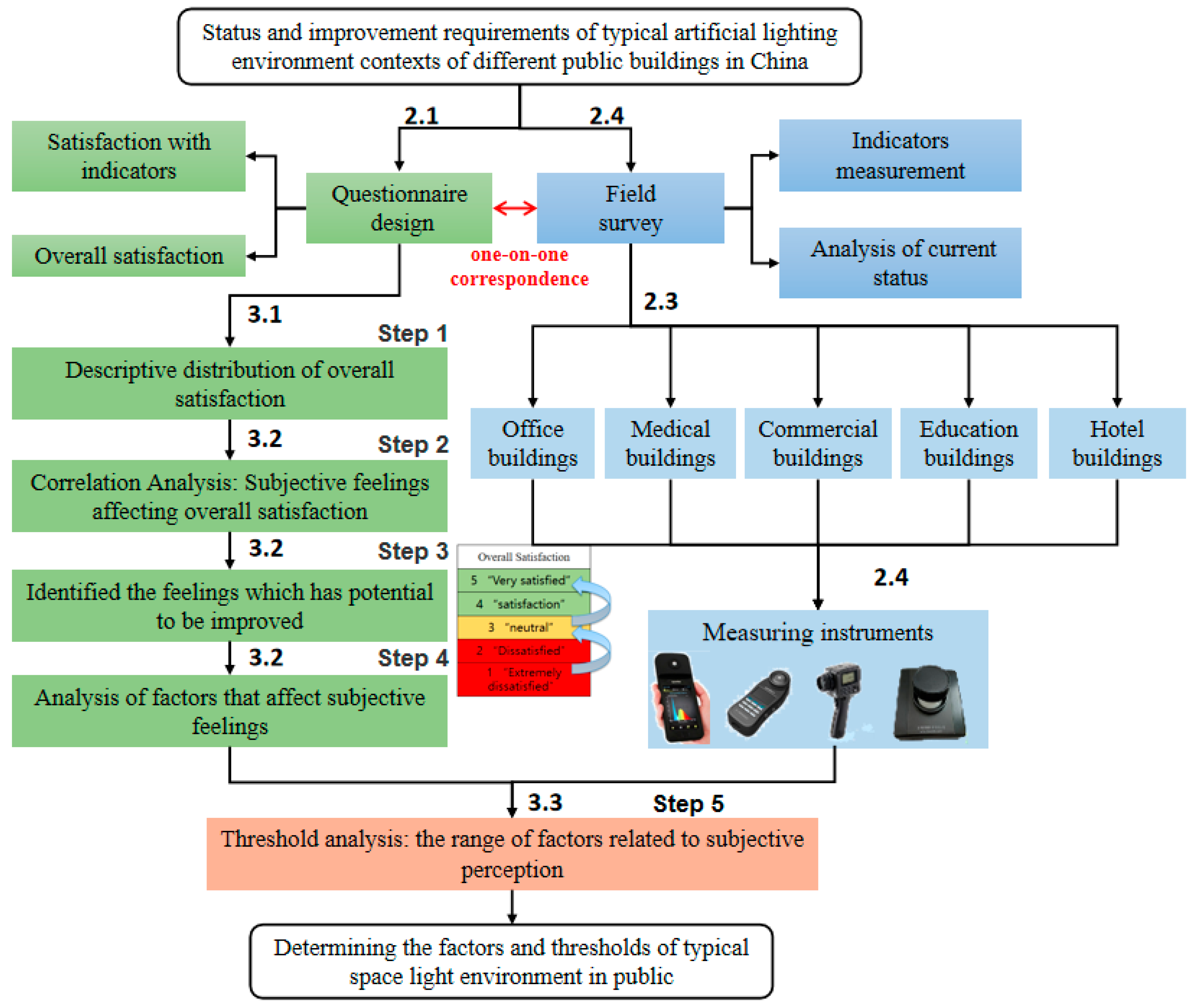

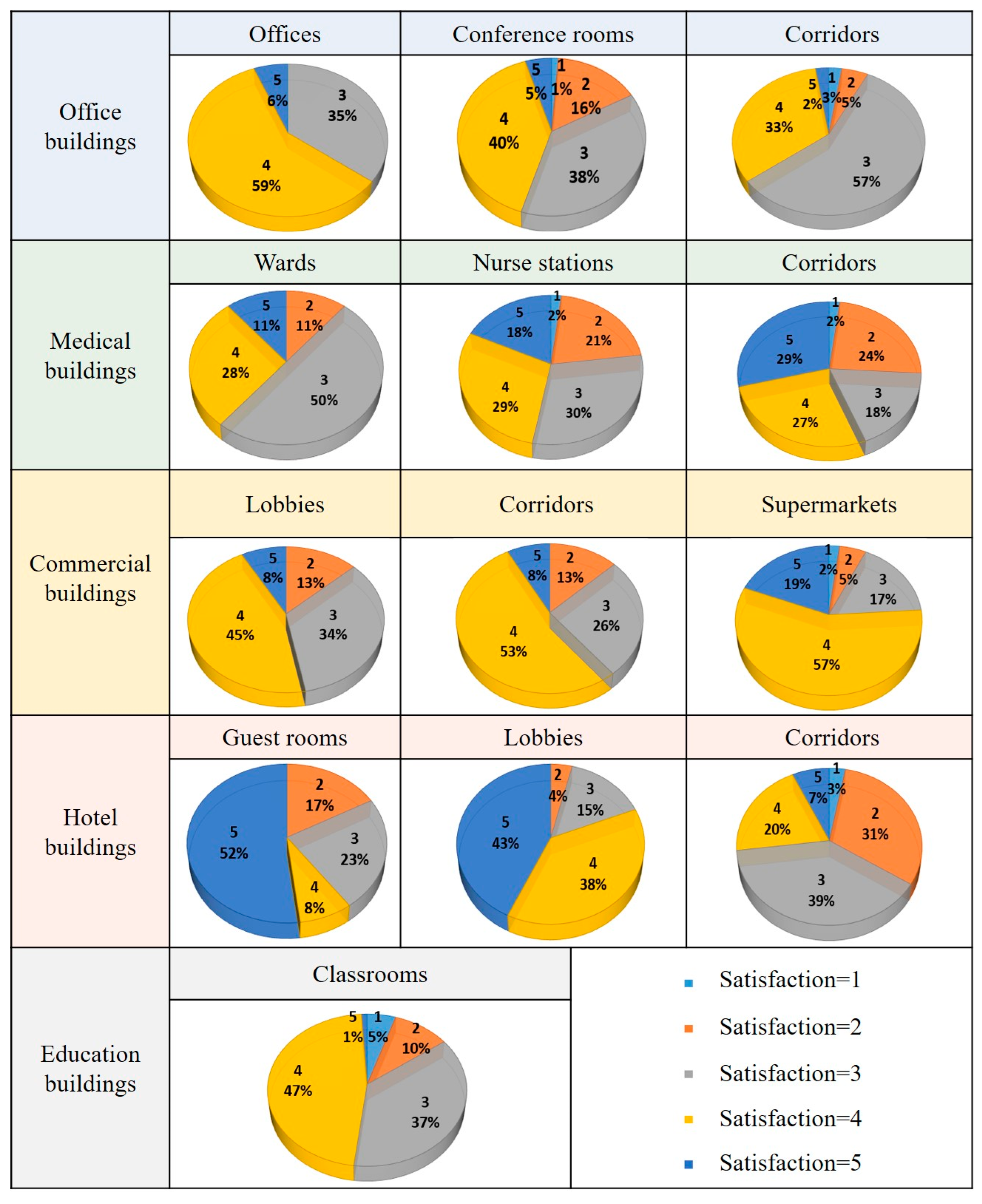

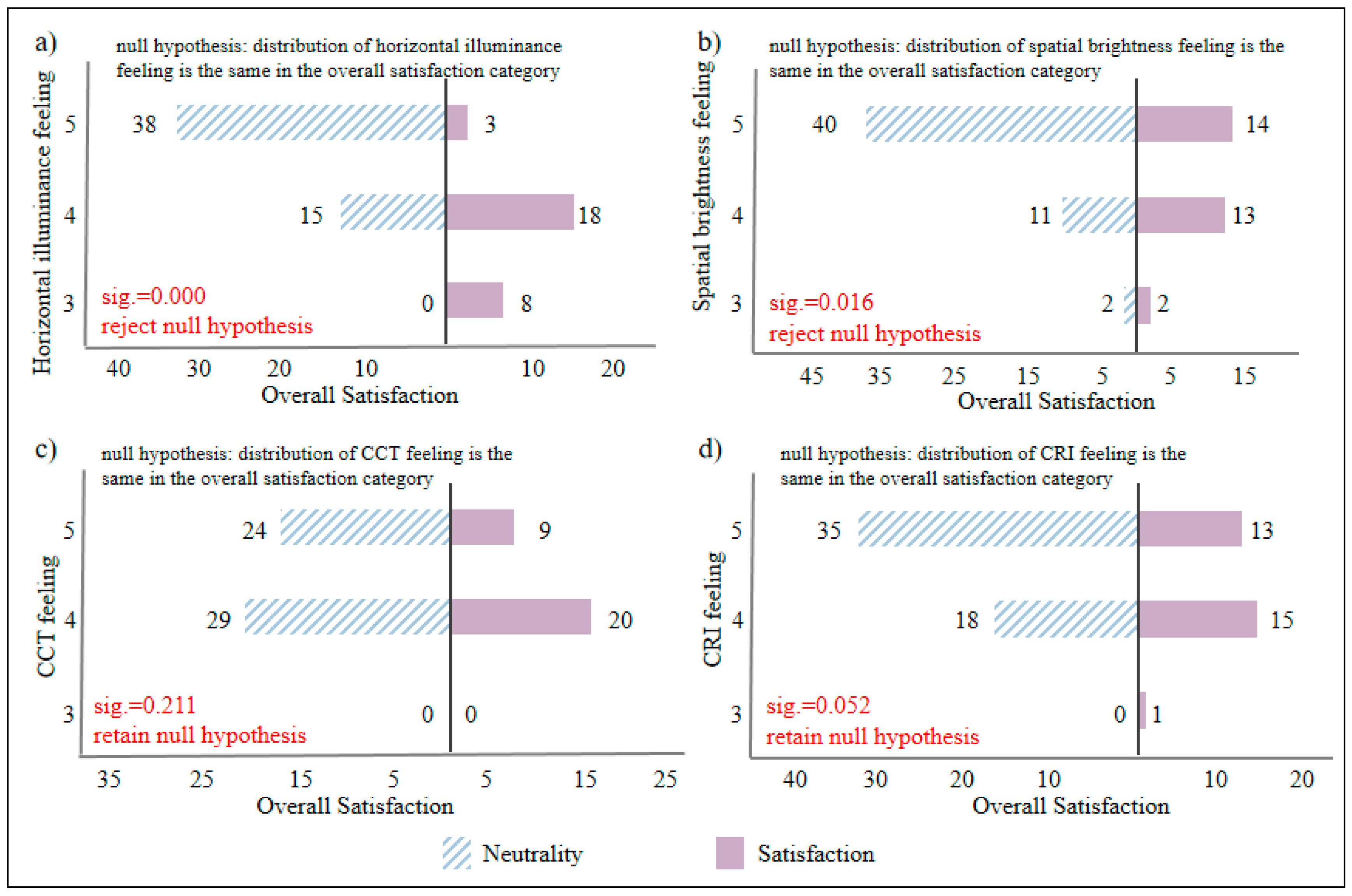
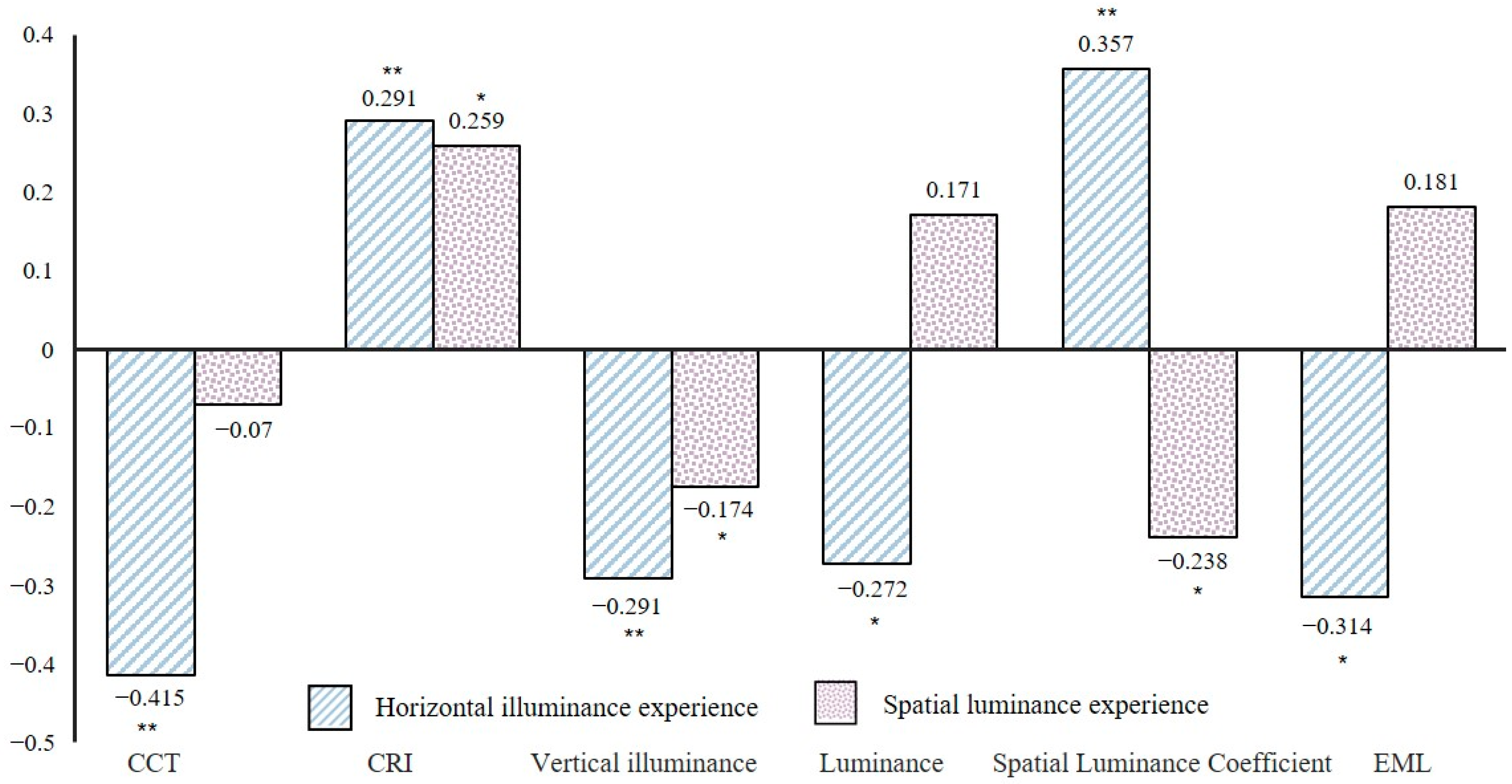
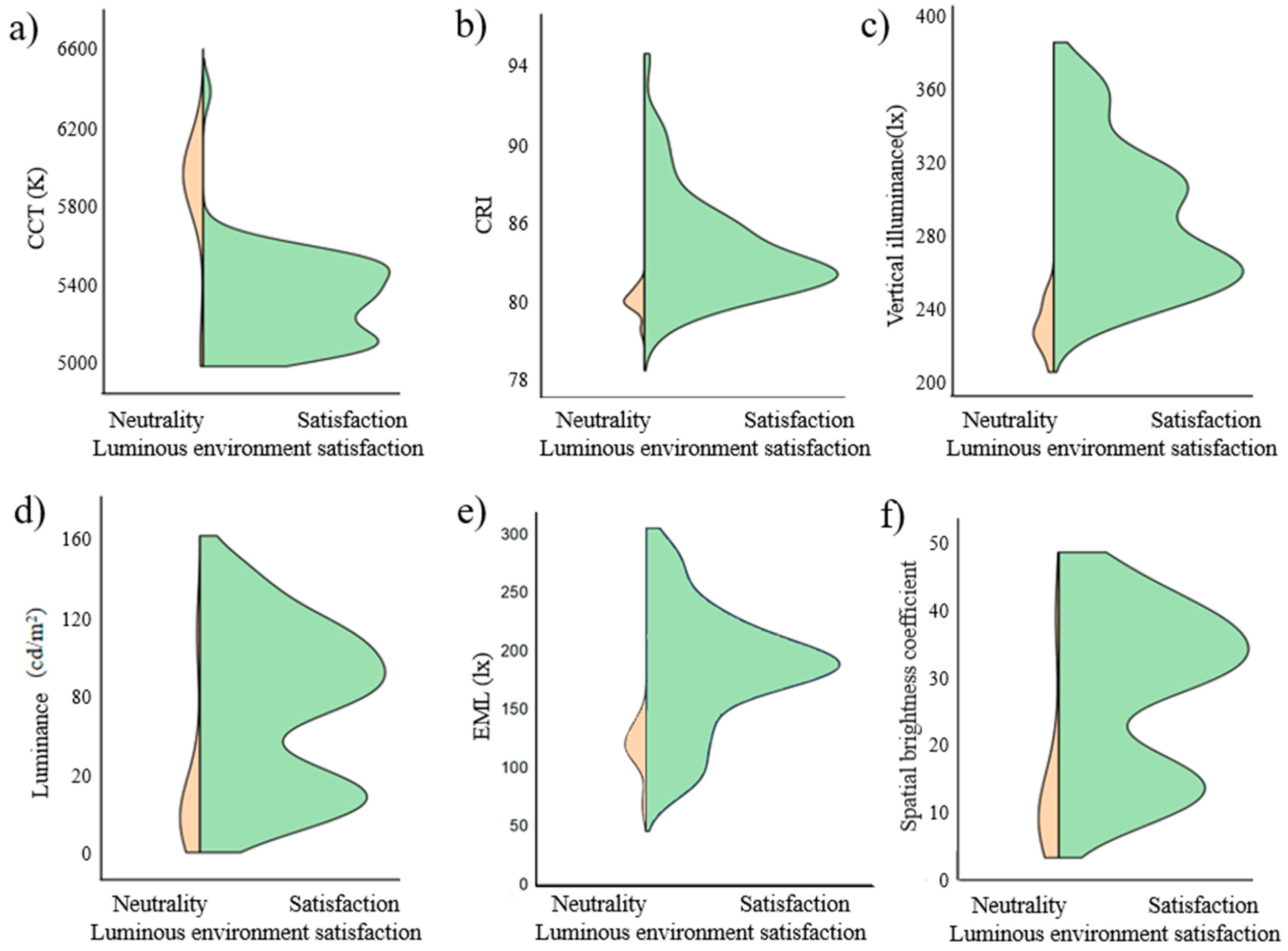
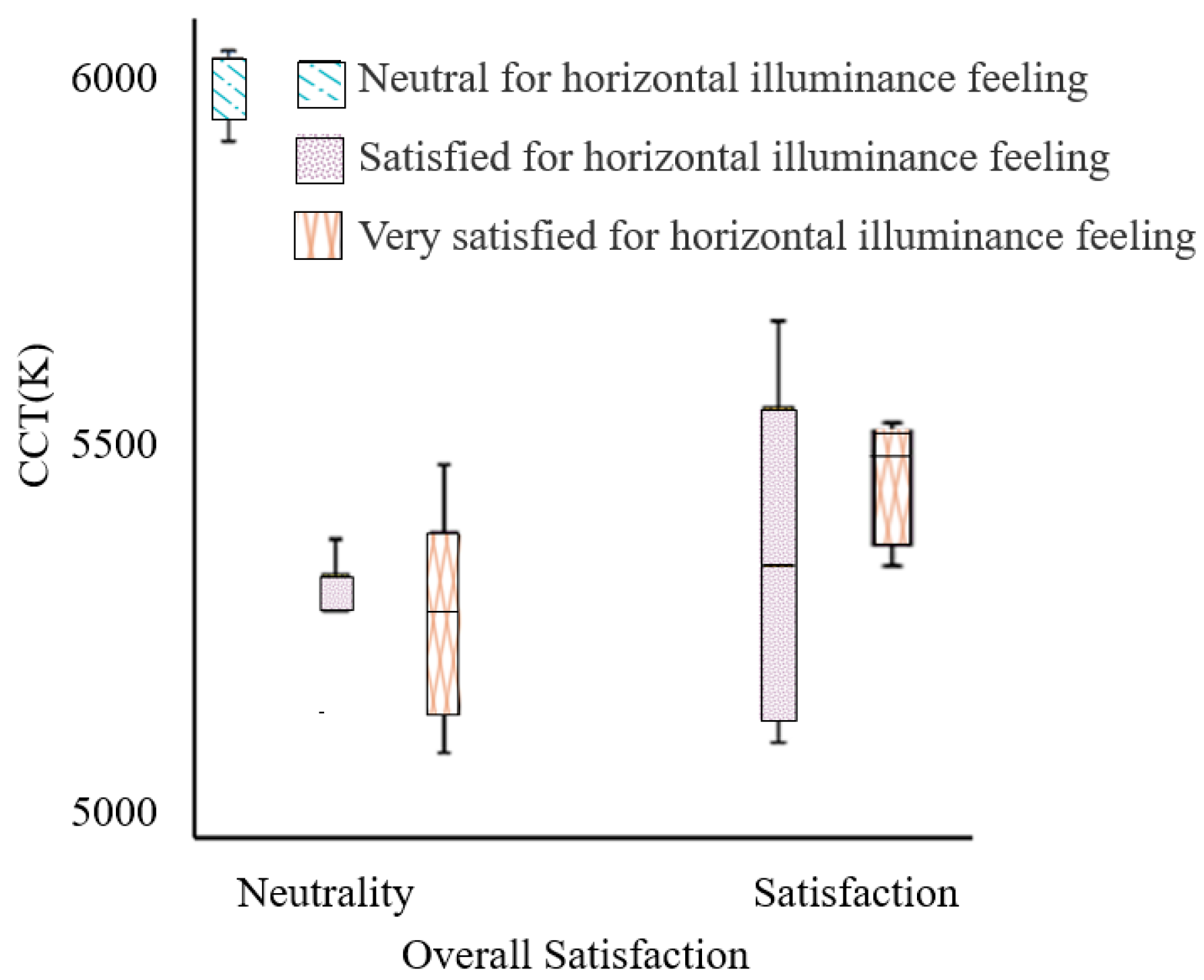
| KMO | Based on Standardized Cronbach Alpha Coefficient | |
|---|---|---|
| office | 0.686 | 0.777 |
| conference rooms | 0.791 | 0.777 |
| corridors | 0.628 | 0.746 |
| Building Type | City | Context | Data Cleaning | Total | Valid | Issued | Standard-Reaching Rate |
|---|---|---|---|---|---|---|---|
| Office | Beijing Shanghai | Office | 82 | 246 | 396 | 475 | 62.1% |
| Conference room | 86 | ||||||
| Corridor | 78 | ||||||
| Medical | Shanghai | Ward | 63 | 168 | 186 | 249 | 90.3% |
| Nurse station | 57 | ||||||
| Corridor | 48 | ||||||
| Commercial | Beijing Shanghai | Lobby | 56 | 166 | 210 | 261 | 79.0% |
| Corridor | 57 | ||||||
| Supermarket | 53 | ||||||
| Hotel | Nanjing Changsha | Guest room | 95 | 237 | 327 | 384 | 72.5% |
| Lobby | 83 | ||||||
| Corridor | 59 | ||||||
| Education | Beijing | Classroom | 606 | 606 | 993 | 1154 | 61.0% |
| Total | 1423 | 2112 | 2553 | 67.4% |
| Building Type | Gender | Age | |||||
|---|---|---|---|---|---|---|---|
| Male | Female | 18–20 | 20–29 | 30–39 | 40–49 | 50–59 | |
| Office building | 174 (70.7%) | 72 (29.3%) | 0 | 156 (63.4%) | 65 (26.4%) | 19 (7.7%) | 6 (2.4%) |
| Medical building | 112 (66.7%) | 56 (33.3%) | 0 | 38 (22.6%) | 39 (23.2%) | 46 (27.4%) | 45 (26.8%) |
| Commercial building | 80 (48.2%) | 86 (51.8%) | 0 | 73 (44.0%) | 51 (30.7%) | 32 (19.3%) | 10 (6.0%) |
| Hotel building | 133 (56.1%) | 104 (43.9%) | 0 | 85 (35.9%) | 91 (38.4%) | 47 (19.8%) | 14 (5.9%) |
| Education building | 352 (66.7%) | 254 (41.9%) | 398 (65.7%) | 208 (34.3%) | 0 | 0 | 0 |
| Total | 851 (59.8%) | 572 (40.2%) | 398 (28.0%) | 560 (39.4%) | 246 (17.3%) | 144 (10.1%) | 75(5.3%) |
| Measurement Parameters | Measuring Instrument | Measurement Accuracy |
|---|---|---|
| Illuminance (E) | Illuminance meter (EVERFINE Z-10) | ±2% |
| Correlated color temperature (CCT) | Spectrometer (EVERFINE SPIC-200A) | ±3% |
| Color rendering index (CRI) | Spectrometer (EVERFINE SPIC-200A) | ±1% |
| Luminance (L) | Luminance meter (KONICA MINOLTA LS-160) | ±4% |
| Percent flicker | Stroboscope (EFB-M) | ±1% |
| Parameter | Chinese <50034> Current Standard | Satisfaction Increased | |
|---|---|---|---|
| Increased to Neutrality | Increased to Satisfaction | ||
| Horizontal illuminance | Office/Meeting room ≥ 300 lx; Corridor ≥ 50 lx | Meeting room ≥ 400 lx; Corridor ≥ 65 lx | Meeting room ≥ 500 lx; Corridor ≥ 100 lx |
| Uniformity of illuminance | Office/Meeting room/ Corridor ≥ 0.6 | Meeting room ≥ 0.75 | Meeting room ≥ 0.85; Corridor ≥ 0.75 |
| Vertical illuminance | Not defined | Office ≥ 270 lx; | |
| Luminance | Not defined | Meeting room ≥ 15 cd/m2 | Office/Meeting room ≥ 40 cd/m2 |
| CRI | Office/Meeting room ≥ 80; Corridor ≥ 60 | Meeting room ≥ 83 | Office ≥ 84; Meeting room ≥ 85; Corridor ≥ 80 |
| CCT | Office/Meeting room ≥ 3300 K | Corridor ≥ 4000 K | Office ≤ 5600 K |
| Spatial brightness index | Not defined | Corridor ≥ 3 | Office ≥ 10 |
| Luminance contrast | Not defined | Meeting room ≥ 0.3 | |
| Parameter | Chinese <50034> Current Standard | Satisfaction Increased | |
|---|---|---|---|
| Increased to Neutrality | Increased to Satisfaction | ||
| Horizontal illuminance | ≥300 lx | ≥350 lx | ≥450 lx |
| Uniformity of illuminance | Desk horizontal ≥ 0.6; Blackboard ≥ 0.8 | Desk horizontal ≥ 0.8; Blackboard ≥ 0.85 | Desk horizontal ≥ 0.9; Blackboard ≥ 0.9 |
| Vertical illuminance | Not defined | ≥300 lx | ≥300 lx |
| Luminance | Not defined | Desk ≥ 30 cd/m2; Blackboard ≥ 10 cd/m2 | Desk ≥ 45 cd/m2; Blackboard ≥ 15 cd/m2 |
| CRI | ≥80 | ≥83 | ≥85 |
| CCT | ≥3300 K | ≥5000 K | 5000–5600 K |
| Spatial brightness index | Not defined | ≥10 | ≥15 |
| Luminance contrast | Not defined | Desk horizontal ≤ 0.8; Blackboard ≤ 0.9 | Desk horizontal ≤ 0.5; Blackboard ≤ 0.7 |
| Parameter | Chinese <50034> Current Standard | Satisfaction Increased | |
|---|---|---|---|
| Increased to Neutrality | Increased to Satisfaction | ||
| Ground illuminance | Ward ≥ 100 lx; Corridor ≥ 100 lx | Nurse station ≥ 150 lx | Ward ≥ 200 lx; Nurse station ≥ 250 lx; Corridor ≥ 150 lx |
| Uniformity of illuminance | Ward ≥ 0.6; Corridor ≥ 0.6 | Nurse station ≥ 0.7; Corridor ≥ 0.65 | Nurse station ≥ 0.8; Corridor≥ 0.7 |
| Vertical illuminance | Not defined | Nurse station ≥ 40 lx | Ward ≥ 50 lx Nurse station ≥ 75 lx |
| Luminance | Not defined | Ward ≥ 20 cd/m2; Corridor ≥ 20 cd/m2 | Corridor ≥ 25 cd/m2 |
| CRI | Ward/Nurse station ≥ 80; Corridor ≥ 60 | Corridor ≥ 80 | Ward/Nurse station/ Corridor ≥ 85 |
| CCT | Not defined | Ward ≥ 4200 K; Nurse station ≥ 4200 K; Corridor ≤ 5500 K | Ward: 4200–4500 K Nurse station: 4200–5400 K; Corridor: 4000–5500 K |
| PF | Ward ≤ 0.03 | Nurse station ≤ 0.25 | Ward ≤ 0.2 |
| Flicker index | Not defined | Nurse station ≤ 0.15 | Ward ≤ 0.1 |
| Parameter | Chinese <50034> Current Standard | Satisfaction Increased | |
|---|---|---|---|
| Increased to Neutrality | Increased to Satisfaction | ||
| Groundilluminance | Hall ≥ 200 lx; Market ≥ 100 lx; Corridor ≥ 100 lx | Corridor ≥ 150 lx; Market ≥ 300 lx; | |
| Uniformity of ground illuminance | Hall ≥ 0.6; Market ≥ 0.6; Corridor ≥ 0.4 | Corridor ≥ 0.6 | Corridor ≥ 0.85; Market (commodity area) ≥ 0.8; Market (meat area) ≥ 0.85 |
| Vertical illuminance | Not defined | Corridor ≥ 50 lx | |
| Luminance | Not defined | Commodity shelves ≥ 50 cd/m2; Fruit and vegetable area ≥ 50 cd/m2 | Hall ≥ 75 cd/m2; Commodity shelves ≥ 75 cd/m2; Meat area/Fruit and vegetable area ≥ 100 cd/m2 |
| CRI | Hall ≥ 80; Market ≥ 80; Corridor ≥ 60 | Market (fruit and vegetable area) ≥ 83 | Hall ≥ 85; Market (meat area) ≥ 83; Corridor ≥ 85 |
| CCT | Not defined | Market (meat area) ≥ 2600 K | Corridor ≥ 3300 K; Market (meat area) ≥ 3200 K |
| PF | Not defined | Market (fruit and vegetable area) ≤ 0.4 | Hall ≤ 0.1; Market (fruit and vegetable area) ≤ 0.25 |
| Flicker index | Not defined | Market (commodity area) ≤ 0.15; Market (meat area) ≤ 0.25 | Market (commodity area) ≤ 0.1; Market (meat area) ≤ 0.1 |
| Parameter | Chinese <50034> Current Standard | Satisfaction Increased | |
|---|---|---|---|
| Increased to Neutrality | Increased to Satisfaction | ||
| Horizontal illuminance | Guest room(bed) ≥ 150 lx; Guest room(desk) ≥ 300 lx; Hall ≥ 200 lx; Corridor ≥ 50 lx | Hall ≥ 240 lx; Corridor ≥ 70 lx | Hall ≥ 280 lx; Corridor ≥ 100 lx |
| Uniformity of illuminance | Hall/Corridor ≥ 0.4; Corridor ≥ 0.4 | Guest room (bed/desk/ ground) ≥ 0.7; Corridor ≥ 0.55 | Guest room(bed/desk) ≥ 0.75; Corridor ≥ 0.65 |
| Vertical illuminance | Not defined | Hall ≥ 50 lx; | Hall ≥ 100 lx; |
| Luminance | Not defined | Guest room ≥ 30 cd/m2; Hall ≥ 75 cd/m2; Corridor ≥ 20 cd/m2 | Guest room ≥ 50 cd/m2; Hall ≥ 100 cd/m2; Corridor ≥ 75 cd/m2 |
| CRI | Guest room/Hall/Corridor ≥ 80 | Guest/Hall) ≥ 85; Corridor ≥ 84 | |
| PF | Not defined | Guest room ≤ 0.3 | Guest room ≤ 0.1 |
| Flicker index | Not defined | Guest room ≤ 0.1 | |
| Spatial brightness index | Not defined | Corridor ≥ 10 | |
| Researcher | Experimental Methods | Subjects | Experimental Space | Factor Conditions | Conclusions |
|---|---|---|---|---|---|
| Rui Dang et al. 2018 [57] | Questionnaire (satisfaction). 20 min | 27 students | Clothing store simulated in a laboratory | 200, 500, 1000, 1500 lx; 3000, 4500, 6000 K | Highest evaluation: 1000 lx and 4500 K |
| Naoyuki Oi et al. 2017 [58] | Questionnaire (preference, brightness, naturalness) | 8 students | Settings for “relaxing” and “studying” | 50, 100, 200, 400, 800 lx; 3000, 4200, 5000, 6500 K | Preference depends on the activities. Studying: high illuminance. Relaxing: low CCT |
| Stéphanie van der Lely et al. 2014 [59] | Cognitive tests, scales, saliva samples | 13 male students | Laboratory with blue light-enriched LED screen | 400–480 nm of screen was 0.32 W/(sr*×m2) | Blue light reduction decreased vigilant attention and alertness at night |
| Jae Hoon Ma et al. 2022 [60] | cognitive tasks, visual perception questionnaire | 13 male students | Immersive virtual environments | 200, 500, 750 lx; 2000, 4000, 6500 K | 4000 K was the most naturally perceived CCT and obtained highest score task at all illuminance levels |
| Jiayi Bao et al. 2021 [61] | Questionnaire (Task Load Index), EEG | 12 students | Laboratory simulated in an office | 300–1000 lx; 3000–6500 K | Lowest mental workload: 3000 K and 750 lx |
| Yan Yonghong et al. 2015 [62] | The change rate of students’ α and β brain waves | 2 students | Classroom simulated in a laboratory | 300, 750, 1000 lx; 2700, 4000, 6500 K | Brain fatigue comes earlier at high illuminance and high CCT illumination |
| This study | Questionnaire (satisfaction) and field study | 1423 volunteers | Actual context in public buildings | 300–1000 lx; 2500–6500 K | CCT: >3300 K in business buildings, ≤5600 K in office buildings |
Disclaimer/Publisher’s Note: The statements, opinions and data contained in all publications are solely those of the individual author(s) and contributor(s) and not of MDPI and/or the editor(s). MDPI and/or the editor(s) disclaim responsibility for any injury to people or property resulting from any ideas, methods, instructions or products referred to in the content. |
© 2023 by the authors. Licensee MDPI, Basel, Switzerland. This article is an open access article distributed under the terms and conditions of the Creative Commons Attribution (CC BY) license (https://creativecommons.org/licenses/by/4.0/).
Share and Cite
Liang, Q.; Jin, L.; Luo, T.; Shi, J.; Xue, P.; Liu, J.; Wang, B.; Jin, X. Status of Typical Artificial Lighting Environments in Different Public Buildings in China, and Requirements for Their Improvement. Buildings 2023, 13, 2283. https://doi.org/10.3390/buildings13092283
Liang Q, Jin L, Luo T, Shi J, Xue P, Liu J, Wang B, Jin X. Status of Typical Artificial Lighting Environments in Different Public Buildings in China, and Requirements for Their Improvement. Buildings. 2023; 13(9):2283. https://doi.org/10.3390/buildings13092283
Chicago/Turabian StyleLiang, Qingxuan, Ling Jin, Tao Luo, Jiaxin Shi, Peng Xue, Jiaping Liu, Bin Wang, and Xuan Jin. 2023. "Status of Typical Artificial Lighting Environments in Different Public Buildings in China, and Requirements for Their Improvement" Buildings 13, no. 9: 2283. https://doi.org/10.3390/buildings13092283
APA StyleLiang, Q., Jin, L., Luo, T., Shi, J., Xue, P., Liu, J., Wang, B., & Jin, X. (2023). Status of Typical Artificial Lighting Environments in Different Public Buildings in China, and Requirements for Their Improvement. Buildings, 13(9), 2283. https://doi.org/10.3390/buildings13092283







